| Siamese fighting fish | |
|---|---|
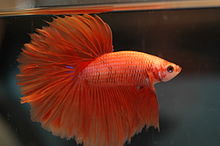 Selectively bred halfmoon male - This Male is either displaying for the sake of it or trying to ward off a rival/lure a mate. Selectively bred halfmoon male - This Male is either displaying for the sake of it or trying to ward off a rival/lure a mate. |
|
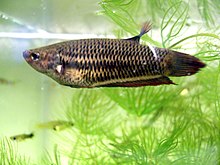 |
|
| Naturally occurring female - This female is stressed, this can be seen by the white colour and slight black banding along her body known as "stress stripes". When not stressed she would be a dark red/blue colour. Another sign to show she is stressed/ill is that she has her fins clamped up. | |
| Conservation status | |
Domesticated
|
|
| Scientific classification | |
| Kingdom: | Animalia |
| Phylum: | Chordata |
| Class: | Actinopterygii |
| Order: | Perciformes |
| Family: | Osphronemidae |
| Genus: | Betta |
| Species: | B. splendens |
| Binomial name | |
| Betta splendens Regan, 1910 | |

A 15-day old free-swimming fry, infected with Piscinoodinium sp. (Velvet disease),
a common fry-killer of this species in captivity - although in adults
this can be treated - in fry it is much harder as they are very
intolerant to medications and water imbalance
B. splendens can be hybridized with B. imbellis, Betta sp. Mahachai and B. smaragdina, though with the latter the fry tend to have low survival rates. As well as these hybrids within the Betta genus, there have been reports of the inter generic hybridizing of Betta splendens and Macropodus opercularis- the Paradise Fish.
[edit] Colours
B. splendens have been affectionately nicknamed "The Jewel of the Orient" due to their beauty and wide range of colours which are produced through selective breeding[citation needed].Wild fish exhibit strong colours only when agitated.[citation needed] Breeders have been able to make this colouration permanent, and a wide variety of hues breed true. Colours available to the aquarist include red, blue, turquoise, orange, yellow, green, bright blue with pink highlights, cream and even true white (the "Opaque" white, not to be confused with albino). The shades of blue, turquoise and green are slightly iridescent, and can appear to change colour with different lighting conditions or viewing angles; this is because these colours (unlike black or red) are not due to pigments, but created through refraction within a layer of translucent guanine crystals. Breeders have also developed different colour patterns such as marble and butterfly, as well as metallic shades like copper, gold, or platinum (these were obtained by crossing B. splendens to other Betta species).
Breeders around the world continue to develop new varieties. Often, the male of the species are sold preferentially in stores because of their beauty, compared to the females. Recently, breeders have developed in females the same range of colours previously only bred in males. Females never develop fins as showy as males of the same type and are often more subdued in colouration.
The true albino betta has been feverishly sought after since one recorded appearance in 1927, and another in 1953. Neither of these were able to establish a line of true albinos. In 1994, a hobbyist named Tanaka claimed to have successfully bred albino bettas.[7]
[edit] Finnage and scale variations
Breeders have developed several different finnage and scale variations:- VeilTail (extended finnage length and non-symmetrical tail; caudal fin rays usually only split once)
- CrownTail (fin rays are extended well beyond the membrane and consequently the tail can take on the appearance of a crown; also called fringetail)
- CombTail (less extended version of the crown tail, derived from breeding crown and another finnage type)
- Half-Moon (caudal fin that forms a 180 degree angle) The edges of the tail are crisp and straight.
- Over-Half-Moon (caudal fin that is in excess of the 180 degree angle) by product of trying to breed half-moons; can sometimes cause problems because the fins are too big for the fish to swim properly. If the fish is able to swim properly, however, OHM's are sought after to breed with Super Deltas to try to get Half-Moons.
- RoseTail (halfmoon variation with so much finnage that it overlaps and looks like a rose)
- Short-Finned fighting style (sometimes called "plakat")
- Double-Tail (the tail fin is duplicated into two lobes and the dorsal fin is significantly elongated; the two tails can show different levels of bifurcation depending on the individual)
- Delta Tail (tail spread less than that of a half-moon with sharp edges)
- HalfSun (Combtail with caudal fin going 180 degrees, like a halfmoon)
- Dragon Scale (scales which are solid rich colour; colours tend to be mostly white)
[edit] Behavior
Males and females flare or puff out their gill covers (opercula) in order to appear more impressive, either to intimidate other rivals or as an act of courtship. Other reasons for flaring their gills is that they are startled by movement or change of scene in their environment. Both sexes will display horizontal bars (unless they are too light a colour for this to show) if stressed or frightened; however, such a colour change, common in females of any age, is very rare in mature males. Females often flare their gills at other females, especially when setting up a pecking order. Flirting fish behave similarly, with vertical instead of horizontal stripes indicating a willingness and readiness to breed (females only). In fact the fish flare their fins and gills as a sign of aggression or flirting with other fish. Bettas sometimes require a place to hide, even in the absence of threats. They may set up a territory centred on a plant or rocky alcove, sometimes becoming highly possessive of it and aggressive toward trespassing rivals.The aggression of this fish has been studied by ethologists and comparative psychologists.[8] Siamese fighting fish will even respond aggressively to their own reflections in a mirror; use of a mirror avoids the risk of physical damage inherent in actual conflict, although it can lead to stress in some individuals. Like other fish, the fighter may respond to the presence of humans and become trained to respond to feeding cues (such as a hand placed over the water's surface). They are quite curious and will watch humans going about their business nearby. When plant leaves reach the surface, they are useful for males to base their bubble nests on. Ethical issues are still debated with the growing activity of pitting males together. Audience bet on the fishes while the bettas savagely attack each other. Males are isolated from one another to avoid such aggression.
[edit] Tanks and tank mates
In captivity, male B. splendens are best housed alone[9] since, as their name "fighting fish" implies, they will aggressively attack and kill (or be killed by) another male in their territory. Putting female and male specimens together is not recommended either (except for breeding, in which the female should be removed immediately after the process) as they will often attack each other. Female bettas can sometimes be kept together in groups of three to seven in larger tanks with hiding places for the less-aggressive females. Male bettas have been successfully housed in large community tanks with other fish that have similar tropical temperature and water quality requirements. Platies, corycats, and African dwarf frogs work best with this fish as well as neon/cardinal tetras and white cloud mountain minnows. Other fish species may be kept in the same tank as a betta, provided the fish does not have long fins that would cause the betta to mistake it for a threatening male betta, and provided the fish isn't significantly smaller than the betta. Endlers (Poecillia wingei) should be fine as long as their fins are small. Bettas might harass and nip at other species that are colourful or have long, flowing fins, and may be nipped at by aggressive tank mates. Careful research should be carried out before selecting tank mates.[10] Although many retail pet shops market very small "bowls" for B. splendens and the fish can, in fact, survive in a small container for periods of time, for optimum health and vigour larger tanks should be considered. A commonly accepted minimum tank volume is 4 to 5 liters.[11] Recommended tank volume is 20 to 40 liters (5-10 US gallons).[edit] Name
Although commonly called "betta," that is the name of a genus. B. splendens is more accurately called by its scientific name or Siamese fighting fish, to avoid confusion with the other species in the genus. The word betta is not pronounced "beta" like the Greek letter, with the "e" sounding like an "a", but with the "e" actually sounding like an "e."[edit] In popular culture
- In the 1963 James Bond movie From Russia with Love, the strategy of the criminal organization SPECTRE is compared to three Siamese fighting in the same tank: Two will fight each other to the death while the third will wait its turn to fight the exhausted victor, symbolizing the conflict between the USA and the Soviet Union, with SPECTRE as the fish that waits.
- The title of S.E. Hinton's 1975 novel Rumble Fish, is an eponymous reference to what two brothers call the breed. In Francis Ford Coppola's 1983 film adaptation, everything appears in black and white except the Siamese fighting fish.
- The Siamese fighting fish has been used as the default background in the beta and release candidate versions of the 2009 Windows 7 operating system, in an apparent reference to the name "Betta." A similar wallpaper and boot-screen also used in the pre-releases of Windows 8.
- A Siamese fighting fish features as a clue in a murder in 2009 film Bad Lieutenant: Port of Call New Orleans.
- Milo, one of the main characters in the Disney Channel's 2010 series, Fish Hooks, is a Siamese fighting fish.
[edit] References
Cupang
Dari Wikipedia bahasa Indonesia, ensiklopedia bebas
(Dialihkan dari Ikan cupang)
| ?Cupang | ||||||||||||||
|---|---|---|---|---|---|---|---|---|---|---|---|---|---|---|

B. splendens
|
||||||||||||||
| Klasifikasi ilmiah | ||||||||||||||
|
||||||||||||||
| Nama binomial | ||||||||||||||
| B. persephone B. picta - Cupang bintik B. pugnax - Cupang penang B. splendens - Cupang petarung [1][2] |
Ikan cupang adalah salah satu ikan yang kuat bertahan hidup dalam waktu lama sehingga apabila ikan tersebut ditempatkan di wadah dengan volume air sedikit dan tanpa adanya alat sirkulasi udara (aerator), ikan ini masih dapat bertahan hidup.
Daftar isi[tampilkan] |
[sunting] Jenis
Perkembangan variasi ditinjau dari segi bentuk dan warna terbilang pesat dalam beberapa generasi terakhir. Beberapa jenis cupang yang dikenal sekarang ini: [3]- Betta pugnax (Forest Betta)
- Betta taeniata (Banned Betta)
- Betta macrostoma (Bruney Beauty)
- Betta unimaculata (Golden Slender)
- Betta picta (Painted Betta)
- Betta anabantoides (Pearly Betta)
- Betta edithae (Betta Brederi)
- Betta foerschi (Purple Saphire Betta)
- Betta akarensis (Sarawak Betta)
- Betta coccina (Clorat's Betta)
- Betta bellica (Standard's Betta)
- Betta tesyae (Peaceful Betta)
- Betta smaragdina (Emerald Betta)
- Betta imbelis (Slugger's Betta)
- Betta splendens (Siamese Fighting Fish)
- Betta albimarginata
- Betta channoides
- Betta balunga
- Betta breviobesus
[sunting] Cupang hias
Cupang hias dibagi lagi menjadi beberapa jenis, yaitu:- Halfmoon (setengah bulan), cupang jenis ini memiliki sirip dan ekor yang lebar dan simetris menyerupai bentuk bulan setengah. Jenis cupang ini pertama kali dibudidaya di Amerika Serikat oleh Peter Goettner pada tahun 1982.
- Crowntail (ekor mahkota) atau serit, cupang jenis ini pertama kali dibudidayakan oleh seorang peternak cupang yang tinggal di daerah Jakarta barat, tepatnya didaerah slipi skitar tahun 1968[rujukan?]( oleh karena itu slipi di sebut juga sebagai pusat ikan cupang hias,nya indonesia ) Ciri utamanya adalah sirip dan ekornya yang menyerupai sisir sehingga di namakan serit.
- Double tail (ekor ganda)
- Plakat Halfmoon
- giant (cupang raksasa), cupang jenis ini merupakan hasil perkawinan silang antara cupang biasa dengan cupang alam, cupang jenis ini ukurannya bisa mencapai 12 cm


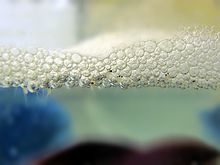
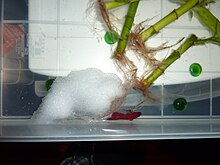


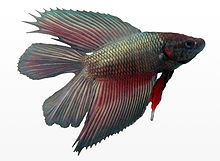

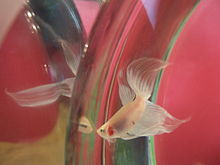










www.d-armanda.co.cc
BalasHapusblog ge sapa kue???
BalasHapus